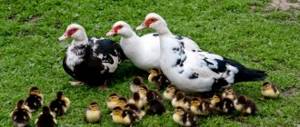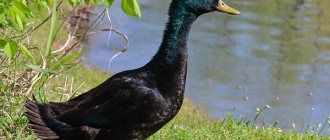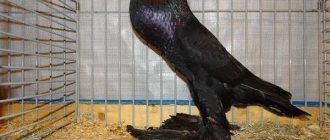History of the breed
This breed has an interesting history. The ancestors of these birds appeared on the territory of Uzbekistan back in the eighteenth century. They entered the country from adjacent territories. A characteristic feature of birds is the presence of fluffy feathers on their limbs.
Selection work using birds of a new variety began to be carried out in Uzbekistan in 1850. Birds with short beaks have become the object of attention of scientists. However, their appearance and flight properties were imperfect. Breeders began to work in this direction. Even gulls and short-billed tumblers were used to select and improve breed properties.
At the same time, the Uzbek line was formed from old-breed pigeons. From them the birds got their appearance and the ability to fight while flying. It represents the flapping of wings during a dive from a height.
Description of the Uzbek pigeon breed
Uzbek pigeons are famous for their pedigree and flying abilities, which have made them in demand both in Uzbekistan and abroad. Uzbek fighting pigeons, or pigeons of Uzbekistan, are distinguished by their beauty and grace.
Uzbek fighting pigeons
This species of bird did not get its name because of its predilection for fighting. The main reason is their special flight style: they somersault and flap their wings as if striking the air, creating an unusual sound - a fight. Nowadays, fighting pigeons are a fairly large group of birds, which includes a large number of breeds.
General description and characteristics
This breed is characterized by fairly clear standards that were established back in 1986. The birds are characterized by a medium-sized body. Its length is 33-37 centimeters. The birds have a dry body with a wide chest that protrudes forward. They are characterized by a low body. At the same time, the neck has a beautiful bend. The birds also have long wings that close over the tail.
Uzbek pigeons are distinguished by dense feathers. Moreover, their shade depends on the type of bird. The appearance of the head is of no small importance. It should have a round shape and compact size. Some bird species also have whiskers and forelocks. The eyes are black or light gray.
Voronezh shakers
The stately pigeons of Voronezh , ironically nicknamed “bugs,” are also classified as shakers. This Voronezh breed includes mobile and active birds, whose habits are reflected in its name. Typical individuals have light eyes, black plumage and a medium body size. Voronezh "beetles" are easy to care for and do not require special conditions for maintenance, while they are kind to their offspring and fly well.
Poltava black-tailed pigeons are also among the ancient breeds of shakers. The breed was brought to Poltava by Zaporozhye Cossacks in the first quarter of the 18th century. Nowadays it is rare, although it is characterized by ease of care and maintenance.
As a result of selection based on the Poltava black-tailed pigeon breed, Novocherkassk black-tailed pigeons were bred. Unlike their ancestors, the latter practically do not fly, since they were formed as an ornamental breed. Novocherkassk stately pigeons have a wider tail and a generally harmonious physique.
Why the pigeon chick is not visible, where they live and appearance
Recommended reading: Hill's h/d for the treatment of heart disease in dogs
Types of Uzbek pigeons
Uzbek pigeons are a fighting species of birds. Their characteristic feature is considered to be a columnar flight. However, there are many species of such birds:
- Chubby - this species of bird lacks the characteristic forelock. They are distinguished by smooth feathers on their heads. At the same time, there are no protruding or raised feathers.
- Nose-toothed - distinguished by thick feathers in the temple area and above the beak. Due to this, this part of the head looks hidden in the lush plumage. This is a rather valuable species of birds.
- Chubby - they have a kind of forelock on the back of their head. Before shows, poultry farmers comb it. Due to this, the birds acquire a cocky appearance.
- Short-billed - birds of this species have a beak length that does not exceed 8 millimeters. There is a special size grid that clearly classifies birds into this category. Pigeons of this species are considered exhibition and decorative. However, there are also demonstration specimens that have managed to maintain flight characteristics.
- Two-foreheads are considered the most famous. Their distinctive feature is their furry legs. Also, the birds have 2 crests at the same time. They are located on the forehead and in the occipital region. Birds have a more powerful body. They are divided into fighting, exhibition, and decorative. Pigeons are characterized by different plumage colors. It can be fawn, black, red, white.
- Small-nosed shaggy-legged ones are considered the most valuable. They belong to the exhibition category. The key difference between the breed is the presence of long feathers on its legs. They reach a length of 10 centimeters.
See also
Diseases that cause green droppings in pigeons and what to doRead
Features of varieties of stately pigeons
The characteristic features of stately pigeons include
- fairly wide chest, somewhat elevated compared to normal
- pronounced wingedness is the drooping of the wings almost to floor level
- a wide, almost peacock-like tail that can contain up to twenty tail feathers
These differences make stately pigeons extremely attractive for keeping in private dovecotes, being an unsurpassed decoration of the collection. There are more and more admirers of this bird species. Once you see such beauty, the irresistible desire to own stunning beauties will never leave you alone.
Moreover, the maintenance and care for them is almost no different than for other groups. With only one difference, due to the extravagant exterior - the edges on the legs and the winged wings, in order to prevent the feathers from touching the litter and not soiling them, it is necessary to equip the place of detention with perches. Their height should be chosen so that the wings do not touch the floor.
The main indicator of status in a group is body type, then the configuration and color palette of the feathers is assessed.
Characteristic body build features
Kachuns fully correspond to their name because while walking they swing their body back and forth. In structure they have a short body , a long neck, turning into a high chest. The tail is flat, short, and carried high. These include the following breeds:
- Altai shawls
- white-breasted
- swans
- Novocherkassk black-tailed
- Rostov colored
- stately Rostov
Shakers got their name because they often shake their heads. They differ from lopwings by a shortened body , a wider and raised tail, and an elongated neck. The shakers include:
- Yeisk two-toed pigeons
- Volga red-breasted
- Voronezh beetles
- Kazan shakers
- Lugansk
- Poltava black-tailed pigeons
- stately Rostov
- Uryupinsk blue
In addition to the difference in build, the species also have different feather decorations on the edges of the legs in the form of stockings, braids or bells , front forelock, rear forelock, double forelock.
Color
As a result of selection, a wide range of feather colors has been achieved. There are doper ones, that is, plain white, black, red, gray, yellow. But there are also multi-colored color-sided, color-tailed, color-breasted and pockmarked.
In addition to the varied colors of plumage , there are breeds that originate from Rzhev pigeons and have a spectacular white stripe on the tail. While creating other breeds on the basis of the Rzhevskaya, it was not possible to get away from the red breast and white stripe.
Flight qualities of breeds
Pigeons are, of course, birds, but as a result of selective selection, some breeds have lost the ability to fly , others hardly fly. Based on their ability to fly, they are divided into 3 categories:
- high-flying
- tumblers
- decorative
High-flying species include certain species of tremors and almost all floaters.
Thurmans are the Rzhev Vislokryla and Syzran, including the addition of the Kazan shakers.
Kachuns and certain types of shakers are decorative.
High demands on the testimony of the article played a tragic role in matters of the ability to fly. Some breeders argue that keeping individuals indoors is due to a decrease in their exterior performance due to flying. They stop holding their head and tail well, and their posture changes. And these are the defining characteristics of stately pigeons.
Due to the fact that in the process of many years of selection, pigeons have lost the ability to fly, there are doubts about the possibility of restoring it with a specific species. And if so, then this will require changing more than one generation.
The hobby of pigeons unites thousands of people all over Russia. Working with birds spiritually enriches a person and makes you look differently at the animal world with its beauty, problems and joys.
Requirements for maintenance and care
The success of pigeon breeding depends on the owners. Under adequate housing conditions, birds can live 15-20 years. Moreover, within 10 years they give birth to offspring. This breed is considered very peaceful. Therefore, it is permissible to keep many individuals in a free enclosure. At the same time, it is important to provide personal space for each bird. Pigeons are provided with their own place - nests and perches.
In order for birds to develop normally, it is important to follow these rules:
- Avoid drafts. It is important to ensure that the floors in the poultry house do not have any cracks and are covered with sawdust. It is recommended to make the walls strong enough.
- Ensure a normal ventilation system.
- Maintain optimal temperature conditions. It should be +20 degrees. If this parameter is exceeded, there is a risk of spreading ticks or other parasites.
- Maintain adequate lighting. Windows or lamps should provide plenty of light.
- Disinfect the room regularly. However, it is prohibited to use substances harmful to birds.
- Place nests on litter. For this, it is permissible to use hay, felt, and straw.
It is important to ensure that birds are safe and do not come into contact with wild pigeons or other birds that spread pathologies.
Diet planning
Wild pigeons eat cereals, grass, and plant seeds. This diet is considered the most suitable for them. Domestic animals require similar nutrition. At the same time, they should receive 20-35 grams of feed per day. The following components should be included in the diet:
- 40% pearl barley or barley;
- 30% wheat;
- 10% legumes, corn, sunflower seeds;
- 10% millet;
- 10% greens – this category includes sorrel, cabbage and other products.
See also
Is it possible to feed pigeons peas, the benefits and harms of the product and how to add it to foodRead
In summer, pigeons eat three times a day, and in winter they have enough food 2 times a day. Feeding depends on seasonal factors. It is selected taking into account the availability of feed. In winter they use more vitamins, in summer they use fresh feed. Sometimes pigeons need to be given peas and cottage cheese. They also need fresh vegetables and fruits.
Feather color as a separate feature
Pigeons are bred for beauty, which, according to pigeon breeding enthusiasts, manifests itself in all areas of the life of this bird. There is beauty in form, flight, and movement. However, the most striking beauty is the color of the feathers.
Stately pigeons are distinguished by a special variety of feather colors. Among the representatives of this breed group you can find birds with plumage colored in the traditional gray, white, yellow, red and black colors.
Pigeons are bred for beauty, which, according to pigeon fanciers, manifests itself in all areas of the life of this bird.
The specially colored feathers of these birds can be found in any part of the plumage. Moreover, there are representatives of breeds that have feathers that perform only a decorative function. These can be stockings, braids, slopes, feathers in the form of a rear or front forelock.
All this variety of pigeons is usually divided into subgroups based on plumage.
- Colour-breasted. This category includes pigeons that are predominantly white, but have other colors on the chest, neck, head and tail. This is the so-called magpie pattern. This group is represented by pigeons from Siberia, the Volga region, and the Southern Urals.
- Colour-sided. These are pigeons that have a special color of coverts and flight feathers. Such a shield can be painted in yellow, red, black and bluish colors. Sometimes transverse black stripes run along the colored spots. Representatives of this color range are the Novocherkassk, Azov and Don regional breed groups.
- Color-tailed. This subgroup contains birds with white plumage, but with a colored tail. Orenburg color-tailed, Novocherkassk black-tailed and Poltava black-tailed pigeons have colored tails.
- Single color. From the name itself it follows that this category includes birds that have a uniform color of plumage. However, pigeons can be colored white, red, black, yellow and dove. This subgroup includes the Voronezh breed line, as well as all kachuns, shakers and lop-winged pigeons.
- Motley. Otherwise, these pigeons are also called speckled. There are more than 2 colors in their color. A feature of this subgroup is the chaotic scattering of spots throughout the body. Breeds of motley pigeons are bred mainly in the Urals (Chelyabinsk), in Yeisk
Reproduction and breeding
Pigeons breed in the spring. However, winter breeding is also considered acceptable. The main condition for successful reproduction is the choice of a partner. Females do this on their own. If we are talking about exhibition specimens, it is worth selecting a male artificially.
Throughout the year, the female is capable of making up to 3 clutches. Each of them should contain 2 eggs. After mating, 7-8 days pass. In this case, the female lays eggs at intervals of 1-2 days. When the first egg appears, it is recommended to remove it to a warm, protected place, replacing it with a dummy. A little later it should be placed next to the second egg.
Expert opinion
Zarechny Maxim Valerievich
Agronomist with 12 years of experience. Our best country expert.
Ask a Question
The incubation period is approximately 1 month. During this period, it is not recommended to disturb the birds. It is recommended to check nests in the absence of birds.
Hatched chicks do not require special care. Pigeons take care of their offspring on their own. At the age of 1 month, pigeons can begin to be fed millet and other crushed grains. To prevent the development of various pathologies, it is recommended to mix antibiotics into the feed. Timely vaccination and control of the presence of parasites are of no small importance.
Breed-specific diseases
Pigeons are susceptible to various pathologies. They are infectious and non-infectious. Birds often encounter salmonellosis and Newcastle disease. The main causes of disease development include the following:
- unbalanced diet;
- contamination of drinking bowls;
- violation of conditions of detention;
- an excessive number of birds in the dovecote.
If birds are kept crowded, there is a risk of them becoming infected with worms. These conditions also increase the risk of ticks or insects spreading. To avoid serious problems, it is important to promptly identify an infected bird, isolate it from the rest of the flock and contact a veterinarian.
Uzbek pigeons are considered a very popular breed. Many farmers breed such birds because they have excellent decorative qualities. For bird rearing to be successful, they need to be provided with quality care and balanced nutrition.











